|
|
||
|
|
|
|
|
|
|
History The original church dates from 1459. Along with its convent it was closed by Napoleon, but re-established by the Franciscan Nuns of Christ the King, founded by Princess Benedetta Savoia Carignano and Angela Canal, a noblewoman from Venice, in 1878. In 1950 work began on a new larger church, designed by the engineer G. Favaretto Fisca and the architect G. Lirussi. This building was consecrated in 1952 and still houses the Institute of the Franciscan Nuns of Christ. Interior A boxy nave and two aisles with a plain coffered ceiling and a shiny marble floor. There is a gallery connecting the church to the convent, and a small chapel to the right of the entrance. Opening times Update August 2021 Recent reports say that this church is now open more often the not, with nuns in attendance and notices of services posted. Vaporetto San Zaccaria map |
||
|
History 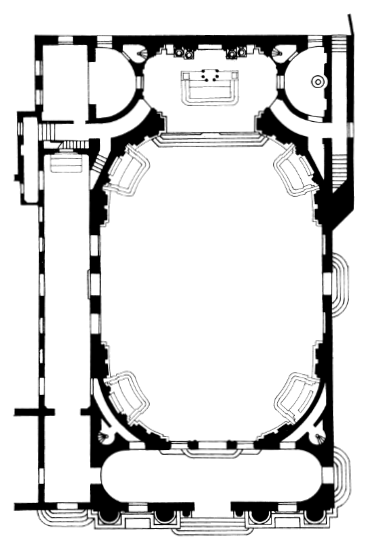 Famous as the church of the Ospedale della Pietà, the orphanage where Vivaldi taught and for whose talented girls he composed most of his concerti and oratorios. It was one of the four great centres of musical activity in 18th century Venice, along with the Incurabili, the Mendicanti and the Ospedaletto. The ospedale for foundlings had been founded in 1346 by a Franciscan monk, but became more secular over time, being under the patronage of the Doge from 1353, and governed by members of noble families. The complex was enlarged in 1388, and modernised in 1493 and 1515. The façade of this original church is probably the one seen in the background of the 1730 painting of The Doge's Palace and Riva degli Schiavoni by Canaletto in the collection of Tatton Park (see detail below). The current building dates from a rebuilding funded by a three-year lottery granted by the Council of Ten in 1727, and another in 1733 when the first didn't reach its target. Having employed Giorgio Massari who had won a competition in 1735, winning out over Antonio Tirali, and a Franciscan friar called Padre Foresti. By 1738 land was being cleared and stone bought. In 1744 part of the old orphanage was demolished and the orphans placed in foster homes. Building took place between Doge Pietro Grimani laying the foundation stone in 1745 and 1762. The church was on a new site adjacent to the site of the old oratory but the hospital wings planned were never built. It was finished well after Vivaldi's death, but it is said that the composer might have advised the architect Giorgio Massari on the positioning of the choirs and the use of a vestibule to provide a barrier to the noises of the Riva. This was to prove the last great church to be built by the Republic. It was consecrated on 14th November1760. The church The façade had only reached the level of the top of the doorcase pediment, (as seen to the right in the Turner watercolour of 1840 see below) but was finally finished in 1906. Massari's planned elevation for the church and ospedale included three statues on the pediment (see below right) but now there's only a cross, reflecting a change in iconographic priorities since the facade was conceived. These statues were to have been Faith, at the apex, triumphing over Hope and Charity, as in Giovanni Battista Tiepolo's fresco on the chancel ceiling inside. Over the entrance is a large bas-relief depicting Charity (an Annunciation?) from c.1913 by Emilio Marsili. Marsili was a Venetian sculptor more famous for his bronze statue of Paolo Sarpi of 1892 outside Santa Fosca, very near his studio. 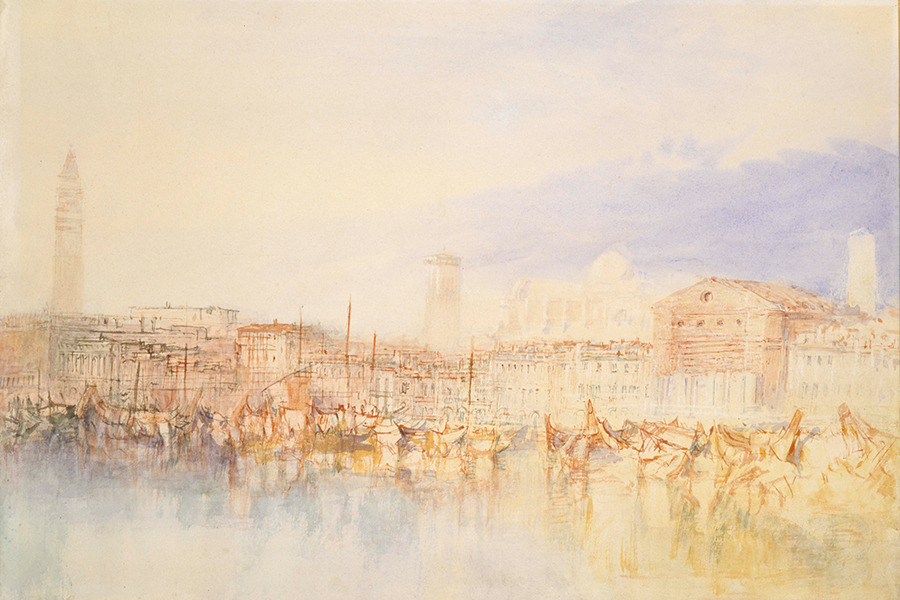 Interior Oval-shaped, like a concert hall, and designed for acoustics, particularly for choral performance. The rococo furnishings, including the pulpit, the confessionals, the grills on the galleries and the organ case, are all to designs by Massari. The roof was on by 1751 and a fresco painter was now required. Giambattista Tiepolo was the safe and obvious choice but he was away in Wurzberg. He returned in 1753 and signed a contract with the governors on 15th April 1754, beginning work the following June 13th. The Triumph of Faith on the ceiling in the nave is sometimes erroneously called an Assumption or Coronation of the Virgin, but the image doesn't precisely embody either interpretation. On the chancel's end wall is a grisaille tondo of the old testament scene of David and the Angel. The frescoes, Tiepolo's last great religious cycle, were unveiled on the 2nd of August 1755. Piazzetta was commissioned to paint five altarpieces for this church. These included the high altarpiece of The Visitation, but he died on 25th April 1754 leaving it unfinished. It was finished by one of his pupils, Giuseppe Angeli. Francesco Capella, Domenico Maggiotto, Angeli and Marinetti, Piazzetta's pupils, supplied the altarpieces on the four nave altars in the early 1760s. Lost art A fourth Tiepolo oval fresco of Fortitude and Peace has been reported and was probably in the vestibule and so likely to have been more weather-beaten and removed during the building of the façade in 1905-6. It is lost but a likely etching exists in the British Museum. 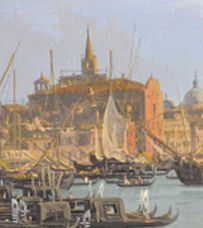 The
church in art The
church in artIn the distance in Guardi and Canaletto views if the Riva degli Schiavone. A watercolour by Turner in the Ashmolean of the riva from 1840 shows the church with it's then-unfinished façade (see above) Opening times For concerts and weekend services. The church is also reputedly open for visits now and charging €3, but this was not found to be true in January 2024 Vaporetto San Zaccaria map
The 14th century church? |
|
|
|
History Dedicated to Saint Blaise and originally built in 1052 by the Boncigli family for the use of new immigrants. From 1470 the Council of Ten allowed the church's use by Venice's large Greek Orthodox community, considered heretics at the time and so only granted the use of this small and non-central church. In 1498 they were given permission to establish a Scuola here, in the name of Saint Nicholas. As early as 1511 Greek soldiers were petitioning the Council of Ten to grant them larger premises, as they were not happy sharing San Biagio, which due to the 'mixture of peoples, tongues, voices and services ... creates a confusion worse than Babylon'. It was also too small for their growing congregation and had no space for burials, so that they were forced to 'mingle our bones with those of galleymen, porters and other low creatures' burying their dead 'upon the public way' where they were 'dug up and thrown into the water within a few days of burial' to make way for others to be buried, this being the sole source of income for the poor church. They eventually moved to San Giorgio in 1543. The present church dates from a rebuilding of 1749-54 by Francesco Bognolo, the architect of the Arsenale, brought about by the previous church falling into disrepair. Closed in 1810 by the French and reopened in 1817 as the parish church of the Navy. True to its more than somewhat functional external appearance it is now part of the naval museum next door, with a naval chaplain officiating at rare services. 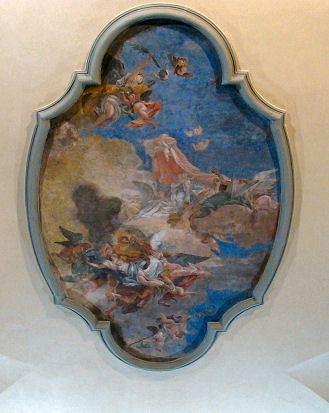 Interior The ceiling panel, showing Saint Blaise in Glory is attributed to Giovanni Scagliaro (see right) a follower, maybe a pupil, of Tiepolo. A monument to Admiral Angelo Emo, by Giovanni Ferrari, was taken from the demolished church of Santa Maria dei Servi and placed here in 1818. He was the last admiral of the Venetian Navy, who defeated the Bey of Tunis in 1784-86 and invented the floating battery, which can be seen with him on his monument (see photo below). There are also five altars taken from the church of Sant'Anna. The local guilds, and their patron saints, are commemorated in the church and include not only the rope-makers and hemp-tanners that you'd expect, but also cap-makers, doughnut vendors and vendors of cheap food. Opening times Very rare Vaporetto Arsenale 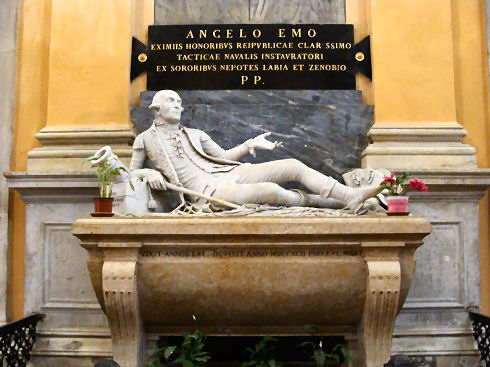 |
|
|
|
San Francesco della Vigna |
||
|
History In 840 a church was built on this site dedicated to Saint Demetrius of Thessalonica. It was renovated in 1070 and dedicated to Saint Bartholomew. In 1291 Bartolomeo Querini, the Bishop of Castello had a hospice built here for the elderly and the infirm, also dedicated to Saint Bartholomew, his name saint. This complex was taken over by the Friars Minor (the Minims) in the 1580s. They converted the hospice to a monastery and rebuilt the church in its current form from 1588, with the continued patronage of the Querini family. It was consecrated on August 8th 1619, dedicated to the Minims' founder Saint Francis of Paola. Between 1675 and 1688 the Bergamo portrait painter Giuseppe Ghislandi, known as Fra Galgario, was a lay brother here. This decision may have been to benefit his art, rather than his soul. He returned to Bergamo and entered another house of Friars Minor there, the convent of Galgario, hence his name. The monastery was suppressed by Napoleon in 1806, became a barracks and was demolished in 1885 to make way for the building of a school. Interior The church was remodelled in the late 18th century, but the ceiling was preserved. An aisleless nave with a barco (nun's gallery) along the back wall with arms stretching half way down the sides. There are four shallow chapels each side with the first ones, at the back, being under the nun's gallery. Art highlights All the good art here is at clerestory level or on the ceiling, the latter being by Giovanni Contarini (1603), a pupil of Titian. They were commissioned by Cesare Carafa at a cost of more than 80 gold ducats. The central panel of The Resurrection is surrounded by New Testament scenes and episodes from the life of Saint Francis of Paola. One of the inevitable paintings by Palma Giovane here depicts four female saints, but has had a hole cut into it top centre for an icon-like image of the Virgin and Child to be inserted - probably some earlier miracle-working image. Also San Francis of Paola Heals a Possessed Man, one of the series of scenes from the life of the saint, is said to be by Giandomenico Tiepolo. The presbytery vault frescoes are by Michele Schiavone. 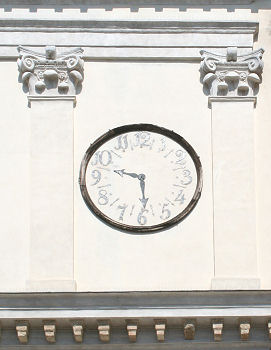 The saint Aside from walking on water and bringing his nephew back to life, the 15th-century vegan Saint Francis of Paola (or Saint Francis the Fire Handler) also famously brought two of his just-cooked pets back to life - Antonella, a favourite trout, after it was fried by a priest, and a lamb called Martinello which had been roasted by workmen. Neither creature is lacking in religious significance, of course. The painted clock You may notice that a clock has been painted on the right-hand side of the façade and wonder why. I asked an attendant and was told that it commemorates the fact that Saint Francis died at 9.30. In the press The church was mentioned in an article about Venice's declining population in the UK Guardian in March 2009. Today the cavernous interior of the church of San Francesco di Paola, complete with a Giandomenico Tiepolo painting, draws as few as eight worshippers to mass. "We did get 150 in for Ash Wednesday," said priest Don Giuseppe Faustini, "and we do fill up for funerals." 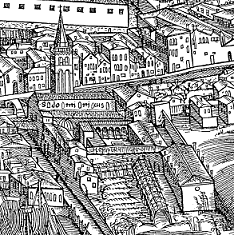 Opening times 8.00-12.00, 4.00-7.00
Vaporetto Giardini |
|
|
|
San Giorgio dei Greci |
||
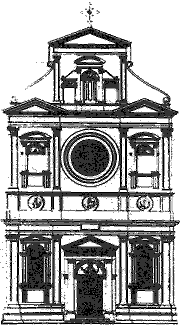 History HistoryBuilt by and for the Greek community in Venice, then consisting primarily of sailors and merchants, who had previously shared the nearby church of San Biagio and who numbered around 4000 at the time. The church was financed by taxing all the Greek ships arriving in Venice. It was built in a Renaissance style reminiscent of Sansovino by Sante Lombardo, from the laying of the foundation stone in 1539 until his death in 1547, and finished by Giannantonio Chiona. The church was consecrated in 1561 with the cupola by Chiona (and not Palladio, as has been claimed) added ten years later. The adjoining late-17th- century buildings are by Baldassare Longhena. They housed the Collegio Flangini (until 1905), named for its sponsor and now a Byzantine studies institute, and the smaller Scuola di San Nicolo, now a museum of Byzantine icons. The wall along the canal is also by Longhena. It encloses the rather lovely courtyard around the church, with olive trees and two fine well-heads. The church itself is free-standing, something of a rarity in Venice. Interior Orthodox in atmosphere, aisleless with a frescoed central dome, painted with a Last Judgement by Giovanni Kyprios (John the Cypriot) supervised by Tintoretto. There's also a women's gallery (about the construction of which Palladio is said to have been consulted) over the narthex at the back, and there are dark wooden stalls all around the plain and grubby walls. But the thing which grabs the attention is the iconostasis, the icon screen - a glowing gold-overload all covered in 46 icons, some painted by Giovanni Kyprios, amongst four artists, but the majority are the work of the Cretan Michael Damaskenos in 1574 - Damaskenos having been in Venice between 1574 and 1582. 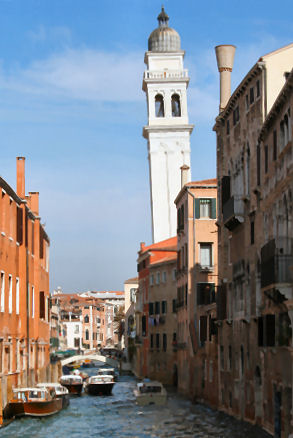 The monument to Gabriele Seviros of 1619 is said to be the first known such work by Longhena. Campanile 44m (143 ft) manual bells Built in 1582-92 by Simone Sorella, and leaning ever since. Its adjoining loggia (see below) is all that remains of the Renaissance cloister. Opening times Monday, Wednesday – Saturday: 9.00-1.00, 3.00-5.00 Vaporetto San Zaccaria map
|
|
|
|
|
|
|
|
History The church of San Giovanni del Tempio and the adjacent hospital of Saint Catherine were built in 1187 by the Knights Templar of Saint John. After the dissolution of the Knights Templar in 1312 the church passed to the Knights of Saint John of Rhodes, later called the Knights of Malta, an order set up to assist pilgrims on the way to the Holy Land. The present church dates from a total rebuilding from 1498 to 1505, when the number of altars was reduced from seven to five, this work being instituted by Grand Master Sebastiano Michiel. The church became known locally as San Giovanni dei Furlani, after the nearby calle dei Furlani, this being the name given to immigrant families from the Friuli region. Both church and monastery were suppressed and plundered by Napoleon in 1806. The altars were stripped and the church used as a theatre. The Commenda di Malta, part of this complex, was where works of art stripped from religious institutions at this time were stored pending decisions as to their fates. The church was used by printers, but was repossessed and reopened by the Knights of Jerusalem in 1839 using altars and sculpture from other suppressed churches. An attached sala capitolare (chapter house) has some faded and damaged medieval frescos the Life of Saint Catherine of Alexandria (the dedicatee of the hospital) which have recently been restored. In recent years there has been talk of restoring the garden (the biggest private garden in Venice evidently) back to its 15th-century appearance, as represented in the old plan (see far below) and opening it to the public via the gate at Campo delle Gatte. Also of creating apartments in the old hospital buildings of the order. The interior A long plain-walled nave with a timber and brick ceiling. Some dark wood panelling to above head height and one altar in the centre of each side wall containing later-inserted full length female saints looking 18th-century. A full width organ gallery at the back. The right wall at the back has a copy of Titian's muscular John the Baptist from Santa Maria Maggiore. The inlaid marble high altar is early-16th-century, by Cristoforo del Legname, and was taken from the demolished church of San Geminiano. Above it there are three statues of saints in niches by Bartolomeo Bergamasco. 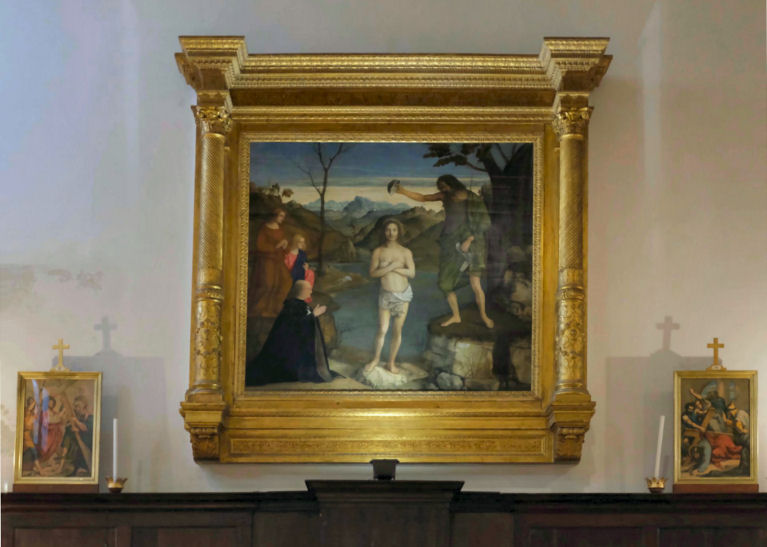 High on the right-hand wall of the nave near the east end is a Baptism of Christ of c.1500 by the studio of Giovanni Bellini (see above). The flat-looking donor figure on the left is Grand Master Sebastiano Michiel who was responsible for the rebuilding here at the same time as his commissioning of the painting. Opposite the painting across the nave, and set upright in a niche, is the tomb slab of Fra' Bertucci Contarini. The large cloister contains a 15th-century well head along with many tombs of knights, and is lined with their painted coats of arms. 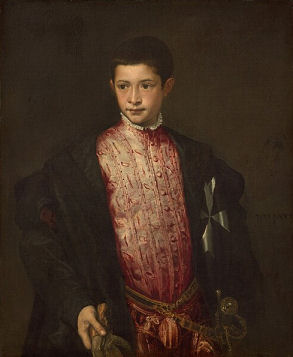 Ranuccio Farnese Titian's famous portrait of the 11-year-old Ranuccio Farnese (see right) was painted in 1542, after the boy had been sent to study in Padua and Venice by Pope Paul III, his grandfather. Ranuccio had been prior here since he was 4 and the portrait was painted on the occasion of his attending a congregation here - the Maltese Cross is prominent on his uniform. He went on to become archbishop of Naples at the age of 14 and by the time he was 19 he was patriarch of Constantinople and archbishop of Ravenna. He became archbishop of Milan in 1564 shortly before dying at the age of 35. The Titian portrait is now in the Washington National Gallery. Vaporetto San Zaccaria or Arsenale map Opening times Unpredictable - Mostly just when hosting Biennale-related art. Update September 2021 Although a current sign on the door says Monday - Saturday 11.00 - 1.00 & 3.30 - 6.30 it seems not to be believed. And click here for photos of a visite exceptionnelle in 2009, by someone else, showing how the cloister looked before the recent restoration, how the Bellini used to be in the presbytery, and the frescoes in the sala capitolare. |
|
|
|
|
||
|
San Lazzaro dei Mendicanti |
||
|
|
|
|
|
History Legend says that a church here was built by the Badoer family in the 9th century and was dedicated to Saint Catherine of Alexandria. It is said to have been rebuilt in 1054 and rededicated to the canonised Pope Leo IX, a supporter of the independence of Venice's churches. The first documented mention dates to 1108. Early in the 16th century the church was rebuilt by Pietro Lombardo and his son and reconsecrated in 1619, with the campanile demolished mid-century. Restored in 1783, with a plain façade retaining the Doric doorway from the early-16th century church. Interior Opening times
Daily 9.00-12.00 |
Interior photo by David Orme |
|
|
History The original church was founded in 812 by Orso Partecipazio (later Doge Partecipazio) with its Benedictine convent established by him in 854. Rebuilt several times, the current church dates from a complete rebuilding by Simone Sorella from 1592 to 1602. But the façade was never even started. Marco Polo, as his will dictated, and with an associated donation, was probably buried here upon his death in 1324, but his sarcophagus is thought to have been lost during the 1592 rebuilding. Vivaldi is said to have rehearsed here, due to the excellent acoustics. Following damage during the Napoleonic War the church was suppressed in 1810 and its art works dispersed. Some of the convent buildings in front of the church were demolished soon after. In 1842 the complex passed to Dominicans, but in 1865 was returned to the city council. The church was badly damaged in World War 1, but restored in the 1950s (see the black and white photos, taken in March 1955 below). Around this time there were also archaeological excavations looking for Marco Polo's remains. The convent buildings were later converted into a hospital, but are now sheltered housing. As part of the music festival at the Biennale in 1984 Renzo Piano built sets for a performance of Luigi Nono's opera Prometheus. In 2012 the church was acquired by Mexico for use as its Biennale location for nine years, with the condition that they restore the place. So in that year, for the first time in years, some small access was possible (see photo below right). And then Mexico pulled out of the agreement. The large hole in the floor, remaining from the archaeological excavations, was still not filled in. In 2016 the TBA21-Academy, a charity devoted to the inter-disciplinary exploration of the oceans, acquired the church. After 'revitalization work', including the filling-in of the hole in the floor, they opened the church in March 2019 as Ocean Space, asserting a commitment to conserving and giving new life to the building itself. More work was planned from Autumn 2019 to transform the building into a 'dynamic interdisciplinary hub for oceanic research and innovation'. A relaunch in 2020 was announced and work on the interior is expected to be completed over the following two years. Interior A huge single space divided in half widthways by a large three-bay screen with a double-sided altar and much decorative ironwork over the aisle arches. One half was for the laity and the other for the nuns, and each side had its own organ. 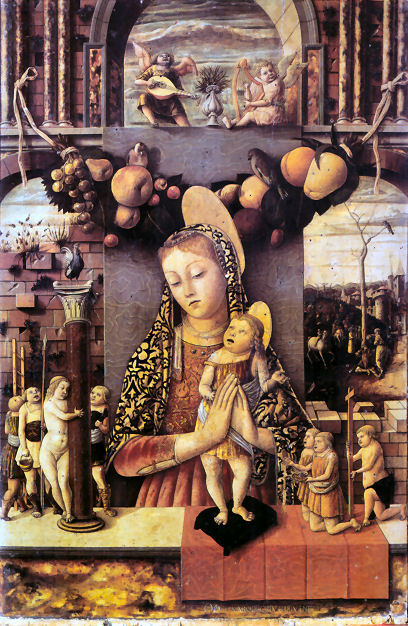 Lost art A panel depicting The Martyrdom of Saint Lawrence with Two Nuns by Jacobello del Fiore of c.1425, now in the Rijksmuseum, seems to have come from the convent here. A typically strange and fruit-swag-full Virgin and Child with Infants Bearing the Symbols of the Passion of c.1460 by Carlo Crivelli (see right) now in the Castelvecchio in Verona, was originally in the monastery here. It is an early work, nonetheless painted after he left Venice (following his release from prison where he'd been sent for adultery in 1457) and before he set up in the Marches. It shows the influence of his master Squarcione, with Flemish embellishments. A panel from a larger polyptych of c.1530/40 depicting Saint Stephen by Girolamo da Santacroce is now in the Brera. A very matching panel depicting Saint Lawrence is in the Courtauld Gallery in London. Nun's misbehaving Well into the 18th century the younger daughters of Venetian nobles were mostly (and famously) likely to end up in convents, the need for hefty dowries meaning that most families' funds could only stretch to the marriage of one daughter if the family were not to be, as they saw it, impoverished. The exploits of these unwilling nuns have been well reported, with San Zaccaria the most famous source of such stories. But here too, the second largest convent after San Zaccaria, a nun called Maria de Riva was found to be leaving the convent at night for liaisons with the French ambassador. When the Inquisitori di Stato ordered her to stay in the convent the ambassador objected and a not-inconsiderable diplomatic dispute ensued. The church in fiction In Dressed for Death by Donna Leon Commissario Brunetti says: “The brick façade of San Lorenzo had been free of scaffolding for the last few months but the church still remained closed...he knew that the church would never be reopened, not in his lifetime...” The church in art The Clothing Ceremony of a Nun at San Lorenzo, a 1789 painting by Gabriel Bella shows the interior of the church. It's in the Querini Stampalia. There is a drawing by Canaletto of c.1742/5 called Capriccio with San Lorenzo, Venice and Houses in Padua in the Morgan Library in New York. It's an imaginary view which nonetheless features the upper part of the façade and a bit of the upper exterior of the nave, with the campanile of San Moise! Opening times Update San Lorenzo opened in March 2019 as Ocean Space and has been open for various exhibitions since then. Check their website for current details. Wednesday - Sunday 11.00 - 6.00 Closed Monday and Tuesday Entrance free 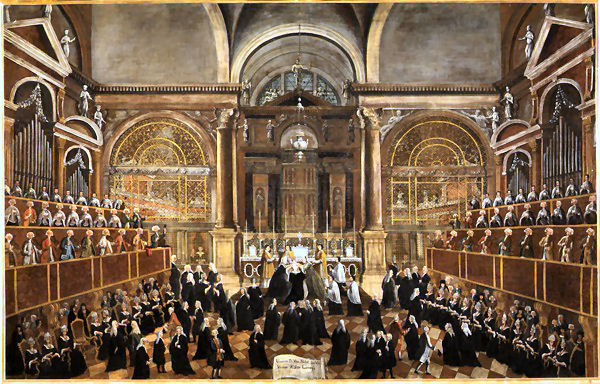 Vaporetto San Zaccaria Vaporetto San ZaccariaThe campo was until quite recently also home to a Dingo cat sanctuary. Read more about this (with photos) on the Venice and Cats page on my other website. map
|
|
|
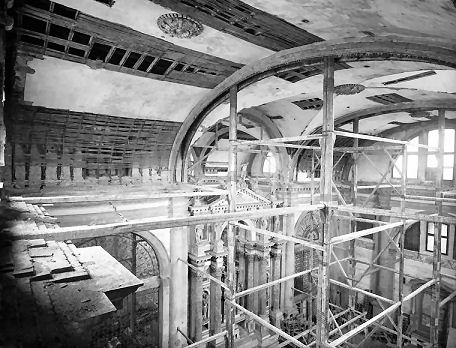 |
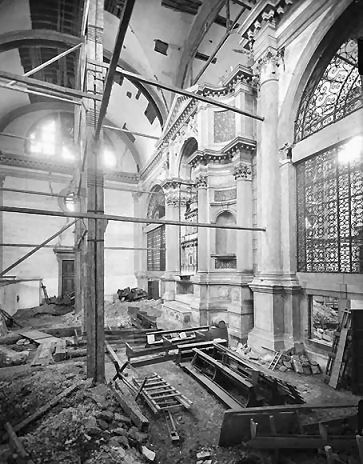 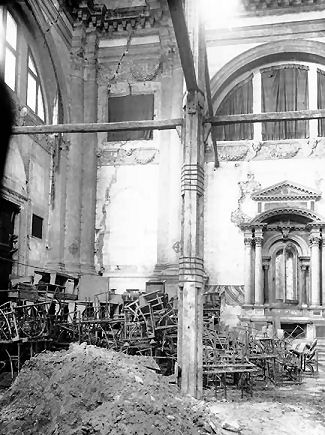 |
|
|
History Named for Saint Martin of Tours, this church is traditionally said to have been founded in 650, possibly by Paduan refugees, but documentary sources mention rebuilding in 932 and 1026. The current church dates from a rebuilding, funded by Antonio Contarini and to a design by Sansovino begun in 1540, and finished around 1619, with consecration following in 1653. The work progressed fitfully, it is thought, due to the poverty of the parish, it being near the Arsenale and populated mostly by poor dock labourers. It had to sell some vineyards to help pay for the church. The façade This was erected in 1897 to a design by engineer Federico Berchet and architect Domenico Rupelo. They retained Sansovino's doorway, to the right of which is a bocca di leone, a lion's mouth, for the posting of anonymous accusations of one's fellow citizens' sins, in this case relating to blasphemy and similar irreverence. The interior This church is Greek-cross shaped with eight chapels in pairs at the corners and it gives the impression of greater width than depth. The interior decoration is much later than the fabric of the church, being mostly 18th-century. The flat ceiling is decorated with trompe l'oeil architectural perspectives by the Brescian painter Domenico Bruni imitating the actual walls - in the middle of which is Saint Martin in Glory by Jacopo Guarana. Some attractive monochrome wall painting too. In a dark corner next to the pulpit is an altar table with legs in the form of angels by Tullio Lombardo (see below right) which came here from the suppressed and demolished church of San Sepolcro which stood on the Riva degli Schiavone. Following the 1966 floods the supporting angels were in a poor state, and so were removed and restored by Venice in Peril in 1991-92. The largest chapel is frescoed by Fabio Canal. The tomb of Doge Francesco Erizzo over the side door was evidently conceived to echo the façade of his palazzo, which is visible over the canal through this door. The left-hand chapel near the front has signs pointing to a sacristy, which can best be described as a 'working' sacristy, but has an interesting fresco covering the ceiling with regular stripes of missing paint, looking just like it was painted between the beams which were later removed. The area behind the altar screen is usually inaccessible, but correspondent Alexander from Toronto asked nicely and got to confirm the presence there of a Road to Calvary by Palma Giovane (see below).
Lost art
Opening times
|
|
|
|
San Pietro di Castello |
||
|
The campanile
54m (175ft) manual bells |
San Pietro in 1890
|
|
Continued on page 2
Cannaregio
:: Castello :: Dorsoduro
:: Giudecca :: San Marco
:: San Polo :: Santa Croce
:: The Islands :: Demolished